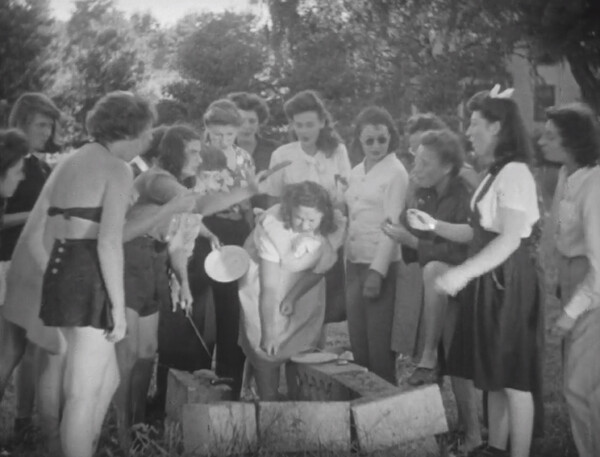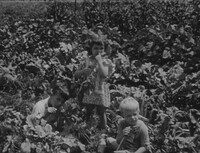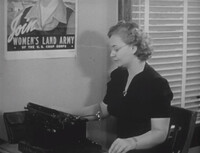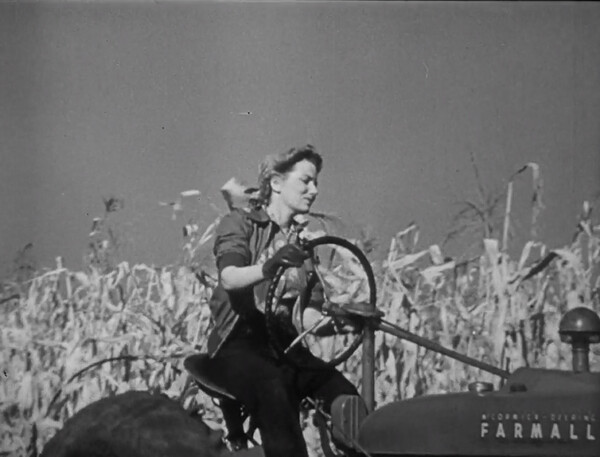Women and the War

Women's organizing groups, like the Women's Land Army, arranged labor and were distinctly social too.
For women on the home front, a conflict between independence and traditional gendered roles raged. This started with the first World War, when women were asked to come out of the house to help harvest agriculture and to work in wartime manufacturing. At the time, women hoped that by pitching in and showing the value of female labor, they would be given suffrage, otherwise known as the right to vote, at the end of the war.76 To organize female farm labor, the Women’s Land Army of America was formed in 1917. Women’s labor outside the home was not without pushback; for instance, while in Britain the nickname “land girls” was popularized to refer to suffragettes that pitched in to work on farms, in the U.S., the term “farmerettes” was introduced with an underlying negative connotation.77 Eventually after the war, women’s suffrage was indeed granted in the U.S. under the Nineteenth Amendment in 1920. Even with the granting of the right to vote, after the war many women were guided back to domestic duties to make way for male employment. The tension would return with the onset of WWII.
Similar to WWI, the second World War required women to once again leave their traditional domestic lives and to seek out paid labor. With WWII, millions of able-bodied male workers were pulled from the workforce to fight, and the U.S. began increasing the number of available jobs on the home front due to the war industry. The hole in the labor force was largely filled with women, opening up opportunities and immense responsibilities. Women were again heads of households, receiving income and managing expenses, but while women covered family obligations for men fighting, nobody relieved women from domestic duties while they took on paid wartime jobs.78 Thus women had to pull double responsibilities during the war. Not everyone was excited for the change in women’s roles either. For instance, while struggling to fill farm positions, Texas and Colorado refused efforts for WLA formation within the state, opting instead to try to fill the hundreds of thousands of vacant positions with migrant labor.79 The image of the delicate “southern lady” was alive and well in Texas.80 While changes took place regardless of opposition, domestic ideals would come back into focus by the end of the war.

Women wearing pants and doing outside labor changed fashion trends, like this shot of a women tilling from Grow Your Own.
Women’s fashion and lifestyle advertisements saw dramatic changes during the wartime years. Women’s fashion trends had an initial relaxation, with shorter skirts, less decoration, and shorter jackets due to war rationing of clothing materials.81 Entering factories and doing blue collar jobs like welding also made for an increase in women wearing jumpsuits, pants, and other apparel traditionally worn by men. Soon though a reversion back towards an emphasis on the housewife and conservative feminine fashion occurred, in what historian Melissa A. McEuen refers to as “home front culture.”82 By 1944, women’s fashion and makeup ads were focusing on attracting and keeping a husband, while beauty supplies were encouraging the maintenance of soft skin and perfect nails to avoid the dirt and grime of working life. Moreover, ads and propaganda emphasized the temporary nature of women’s labor through the encouragement of purchasing war bonds as a nest egg for married life, and the envisioning of home labor-saving machine purchases for homemakers.83 As apparent from the baby boom after WWII, many women were interested or susceptible to the encouraged domestic ideals.

Farm work, like this shot of a woman detasseling corn in Victory Harvest, was not a viable job for many due to the low pay and seasonal hours.
Not all women were highlighted for their wartime contributions. In 1940s segregated America, propaganda efforts, like MPS films, focused on white, middle class women while ignoring minority women. Entire MPS films in the IU collections can be viewed without a single minority woman being visible on screen. Ads from the era that did show African American women mainly depicted them as supporting or being subservient to white women, often in mammy role framework.84 Although white women were shown patriotically taking over jobs in farming and industry and were deemed heroes for taking on paid labor while maintaining domestic responsibilities, African American and other minority women regularly held paid labor positions in addition to household duties, even before the war started. The African American community also warned that wartime opportunities were only open temporarily and that black women would be pushed back to lower wage positions after the war.85 Even victory gardens were largely branded as an activity for white, married, middle-class women.86 Although African American women did join the WLA, the majority of members were white and middle-class as the temporary farming roles didn’t pay well enough to support individuals without other financial means.87 Likely in support of segregation, U.S. propaganda, like MPS films, largely ignored the working roles of African American and other minority women during WWII.

Doing work often included working with, or in this case around, one's children, even in the victory garden.

While not universally appreciated, the Women's Land Army played a big part in organizing women's labor.



